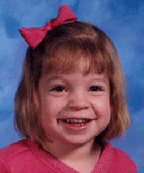 |
Julia Dopheide of Omaha has Sanfilippo Syndrome Type A. |
“We believe that microbubbles may be used effectively to deliver medications across the blood brain barrier, including medications that could better the lives of people with genetic disorders” said Thomas Porter, M.D., a professor of cardiology at UNMC and the recipient of the award. “This is very interesting research, and it will be very exciting if it turns out to have practical applications.”
The blood brain barrier is a semi-permeable layer of tissue that prevents many medications, as well as many harmful substances, from reaching the brain.
Dr. Porter received the research award from “Julia’s Hope: The Sanfilippo Syndrome Medical Research Foundation Inc.” This is a volunteer non-profit organization promoting research toward a cure for Sanfilippo Syndrome Type A and related neurodegenerative disorders. Julia’s Hope was founded in 2000 by Omaha residents Andy and Rebecca Dopheide, whose daughter Julia has Sanfilippo Syndrome Type A.
“We’re very excited about the promise of Dr. Porter’s research,” Andy Dopheide said. “These are little steps toward a cure, but they’re very important to the families who are affected by this disease. We’re very appreciative of his work, and we’re happy to assist with his research.”
|
KETV’s Bill Randby and Julie Cornell will host the event. Cost is $75 per person for those who attend the silent auction, dinner and oral auction. The silent auction begins at 6 p.m., with the dinner scheduled for 7:30 p.m. For $100, attendees can also attend a pre-party from 5 to 6 p.m., when they can preview the silent auction items. Corporate tables of 10 are available for $1,000, which also includes a mention in the event program. Rebecca Dopheide, the organizer of the event, said the silent auction will include about 100 items, ranging from golfing items and Notre Dame football tickets to a trip to Vail, Colo. About 10 items will be auctioned at the oral auction. Registration deadline for the event is Jan. 23. For more information, contact Rebecca Dopheide at 330-0133 or dopheides@msn.com. |
The Dopheides began their foundation to try to stimulate research in Sanfilippo Syndrome, which has an occurrence rate of 1 out of every 25,000 live births. There are four different enzyme deficiencies that cause Sanfilippo syndrome; therefore, the syndrome is classified as being either type A, B, C or D.
When Julia Dopheide, now 6, was diagnosed with Type A of the disease, her parents were surprised to learn that her condition couldn’t be cured, Andy Dopheide said. Only patients’ symptoms can be treated. Julia Dopheide currently sees Brad Schaefer, M.D., the director of Genetic Medicine at the UNMC Munroe-Meyer Institute. William Rizzo, M.D, a pediatric metabolic disease specialist at UNMC, is a scientific advisor to the Julia’s Hope foundation.
“We decided that the quickest way to a cure was to promote research,” he said. “The best way to do that was to raise money, so we formed the foundation.”
Soon thereafter, the foundation began its fund raising. Currently, it has two major fund-raising events each year – a silent auction and dinner in the winter (see sidebar) a golf tournament in the fall.
Each year, the SSMRF solicits proposals for research funding. The foundation’s scientific advisers review the proposals, and specific projects are funded. This year, the SSMRF awarded funded to three proposals totaling more than $100,000.
Dr. Porter’s research into treating the disease will use an animal model, and it will build upon work he’s already done with using microbubbles to study and treat heart disease. His research has shown that microbubbles filled with specific gases can be used to study blood flow into the heart. The research also has shown that microbubbles can be used for drug delivery. Researchers are studying ways in which drugs can be attached to microbubbles, delivered to a specific location, and then released in that area when ultrasound causes the bubbles to “pop” or “bounce,” knocking the drugs off of the microbubbles.
“We know that ultrasound, when delivered appropriately, causes the bubbles to release drugs bound to them,” Dr. Porter said. “We think that when this happens, these bubbles will put little holes in the vessel linings of the blood brain barrier. We may be able to use these microscopic holes to get certain genes into the brain that would counteract some of the genetic disorders that are associated with Sanfilippo syndrome and other disorders.”
The small holes would close within a couple of hours, which is important, Dr. Porter said.
“The blood brain barrier is a good thing, because it protects our brain from infection,” Dr. Porter said. “With the microbubbles, the barrier would be open for only a little bit, just enough to get the medicine through.”